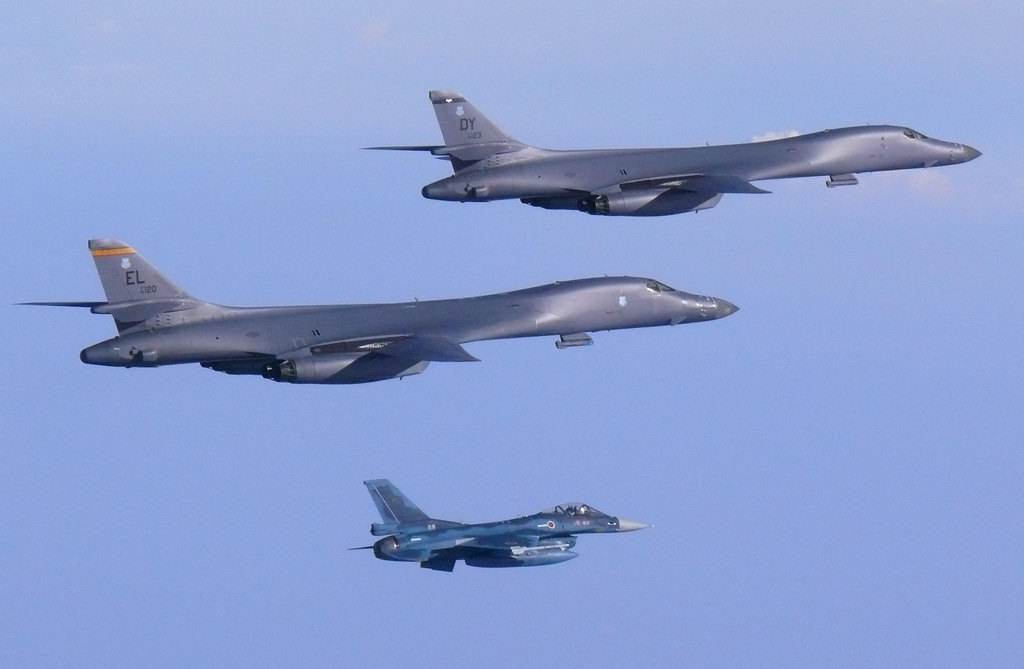One Piece at a Time: The ‘Accumulation of Events’ Doctrine and the ‘Bloody Nose’ Debate on North Korea
Over the past few weeks, experts have engaged in a debate over the legality of pursuing a “bloody nose” strike on North Korea, an option reportedly being considered by the Trump administration (at least until recently). This debate has been propelled forward by an article published in Lawfare by Shane Reeves and Robert Lawless where they describe the “bloody nose” strike strategy as follows:

Published by The Lawfare Institute
in Cooperation With

Over the past few weeks, experts have engaged in a debate over the legality of pursuing a “bloody nose” strike on North Korea, an option reportedly being considered by the Trump administration (at least until recently). This debate has been propelled forward by an article published in Lawfare by Shane Reeves and Robert Lawless where they describe the “bloody nose” strike strategy as follows:
In effect, the proposal would allow for a timely and proportional response against North Korean sites in the event of another nuclear test or missile launch. For example, such a strike might include using force to target a North Korean missile site or a military base. The hope would be that such a strike would “bloody Pyongyang’s nose” and “illustrate the high price the regime could pay for its behavior” without “igniting an all-out-war on the Korean Peninsula.”
Several scholars have since authored formidable critical responses to Reeves’s and Lawless’s conclusion that “[t]here is a strong argument such a strike would be lawful[,]” including Kevin Jon Heller, Michael Schmitt and Ryan Goodman, and Craig Martin.
Other reactions, though critical as well, have been more open to the possibility of lawfully using force against North Korea. Among them are Charlie Dunlap’s post on his blog Lawfire and Masahiro Kurosaki’s recent post on Lawfare. Concerned by the 16 missiles that North Korea launched in 2017 alone, Dunlap remarks that “context matters: A single, isolated launch of a missile that’s somehow known to be unarmed is one thing, but a pattern of launches from a rogue regime issuing repeated threats about nuclear attacks is something quite different” (emphasis added). Kurosaki, meanwhile, emphasizes the important role that intent plays for Japan in ascertaining whether an armed attack has taken place: “an intent-based armed attack determination is to be made based on ‘a comprehensive assessment of international affairs, the demonstrated intent of the opponent state, and the means and patterns of attack’. Context thus does matter to Japan in assessing whether there has been an armed attack” (emphasis added).
What these two latter pieces have in common is their reliance on something resembling the so-called “accumulation of events” doctrine, also known as the Nadelstichtaktik or ‘needle-prick’” theory. As described by Norman Feder in a rather obscure 1987 essay entitled “Reading the U.N. Charter Connotatively: Toward a New Definition of Armed Attack,” this doctrine was originally invoked by Israel to justify its military incursions into Lebanon during the 1970s. At the time, Israel argued that, even though terrorist attacks committed by the Palestine Liberation Organization did not individually amount to armed attacks under international law, they constituted an armed attack triggering a right to individual self-defense under Article 51 of the U.N. Charter when considered altogether.
The accumulation of events doctrine resembles the category of a “continuous offense,” i.e. “a breach of the criminal law not terminated by a single act or fact, but which subsists for a definite period and is intended to cover or apply to successive similar obligations or occurrences.” Imagine someone wants to steal a whole set of chess one piece at a time. Halfway through—or even before that—it is pretty clear that the unifying intent behind the discrete acts of taking this pawn or that bishop points to the final goal of stealing the whole set. The appropriate punishment must take into account the ultimate objective and not merely the subtraction of each individual piece. A few years ago, I proposed this analogy of a continued crime to Norman Feder, but he doubted the convenience of including an element of mens rea in the self-defense analysis. Yet he conceded that, under the accumulation of events doctrine, the aggressive intent (or animus aggressionis) of the attacker may work as a unifying criterion for a series of discrete attacks, not only from the standpoint of the attacker themselves but also for the victim.
Notably, the accumulation of events doctrine was not accepted by the U.N. Security Council when it was invoked by Israel. Echoing some of the reasons for resisting this approach, Christian Tams has argued that, although the accumulation of events doctrine could, in principle, help to justify the right of self-defense against the menace of possible armed attacks by non-state actors, the international community should not embrace it due to the risk that it would give states more open-ended license to use force.
That said, the accumulation of events doctrine has more support in both theory and practice than Tams allows. Indeed, Goodman and Schmitt themselves seem to accept it in noting that “unless it could be reasonably concluded that subsequent missile tests would be conducted and that a forceful response would be necessary to stop them, the armed attack would neither—be imminent, nor could the tests be treated as one in a series of actions that constitute an on-going campaign that in its entirety constitutes an armed attack” (emphasis added). Therefore, under their theory, if the facts were different enough to warrant the reasonable inference that they are connected—and this is a big ‘if’—such an ongoing campaign could theoretically amount to an armed attack.
Moreover, in practice, the accumulation of events doctrine has been relied upon by several states, as documented by Tom Ruys in his canonical monograph on the concept of an armed attack under the U.N. Charter. Ruys explains that, according to this doctrine, “incidents that would in themselves merely constitute ‘less grave uses of force’, can, when forming part of a chain of events, qualitatively transform into an ‘armed attack’ triggering the right of self-defence” (p. 168). Though always mindful of the risk of disproportionate reactions, Ruys provides evidence (albeit not unequivocal according to him) that several states in addition to Israel have relied on this doctrine in the past, including the United States, Russia, China, Lebanon, Iran, Iraq, Liberia and Sudan. Further, Ruys contends that the International Court of Justice itself has “implicitly” endorsed the doctrine in the Nicaragua, Oil Platforms, and Democratic Republic of the Congo v. Uganda cases. Ruys also points out that the doctrine enjoys considerable support among legal scholars, including such prominent scholars as Ian Brownlie, Rosalyn Higgins and Yoram Dinstein. More recently, Ruys has also referred to this doctrine in relation to the recent assassination attempt of a Russian defector on British soil while recommending that it be “construed narrowly.”
I believe that the accumulation of events doctrine adds appropriate complexity to an already necessarily complex debate. The decision to use force or to engage in an armed conflict should never be taken lightly by any community, and the international community is no exception. But no community can afford irresponsible appeasement either. Thus, scholars and policymakers would be wise to pay heed to this additional dimension of the argument, albeit with two caveats.
First, the accumulation of events doctrine only makes sense to determine if an armed attack has already taken place, even cumulatively speaking, making any discussion of preemptive or preventive self-defense irrelevant. Indeed, once a series of discrete attacks are deemed as amounting overall to an armed attack, then the discussion on whether or not we should wait for an armed attack to occur before we preventively strike is moot, since the attack can be said to already have occured. This means that the accumulation of events doctrine might actually take the debate a bit further than the ‘bloody nose’ discussion suggests, since the latter operates on the premise that an armed attack has not yet taken place, but is likely.
And second, although Ruys and Tams are right to be cautious about the risk of abuse inherent in this doctrine of accumulation of events, it is necessary to remember that every institution can be abused, including the traditional right of self-defense. Since it is premised on the very existence of a consummated armed attack, the accumulation of events theory also falls within the spectrum of the right of self-defense, so if it can be abused it is only because the traditional right of self-defense can itself be abused. In the meantime, the spirit of responsible pacifism enshrined in the U.N. Charter demands that we keep a close eye on the chess set, lest it disappear one day under our very nose one piece at a time.


.jpg?sfvrsn=407c2736_6)


